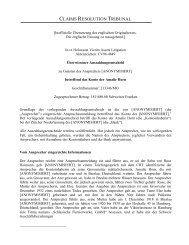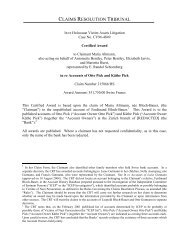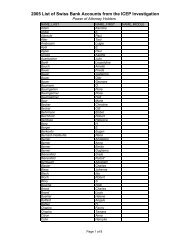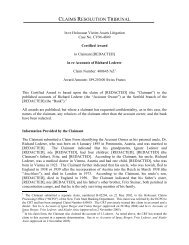weiss, helene - Holocaust Victim Assets Litigation (Swiss Banks)
weiss, helene - Holocaust Victim Assets Litigation (Swiss Banks)
weiss, helene - Holocaust Victim Assets Litigation (Swiss Banks)
Create successful ePaper yourself
Turn your PDF publications into a flip-book with our unique Google optimized e-Paper software.
1 See Independent Commission of Experts Switzerland - Second World War, Switzerland, National Socialism and<br />
the Second World War: Final Report (2002) (hereinafter “Bergier Final Report”); see also Independent Committee<br />
of Eminent Persons, Report on Dormant Accounts of <strong>Victim</strong>s of Nazi Persecution in <strong>Swiss</strong> <strong>Banks</strong> (1999)<br />
(hereinafter "ICEP Report"). The CRT has also taken into account, among other things, various laws, acts, decrees,<br />
and practices used by the Nazi regime and the governments of Austria, the Sudetenland, the Protectorate of Bohemia<br />
and Moravia, the Free City of Danzig, Poland, the Incorporated Area of Poland, the Generalgouvernement of<br />
Poland, the Netherlands, Slovakia and France to confiscate Jewish assets held abroad.<br />
2 See Bergier Final Report at 443-44, 446-49; see also ICEP Report at 81-83.<br />
3 As described in the Bergier Final Report and the ICEP Report, the <strong>Swiss</strong> banks destroyed or failed to maintain<br />
account transactional records relating to <strong>Holocaust</strong>-era accounts. There is evidence that this destruction continued<br />
after 1996, when <strong>Swiss</strong> law prohibited destruction of bank records. Bergier Final Report at 40 (stating "[i]n the case<br />
of Union Bank of Switzerland . . . , however, documents were being disposed of even after the Federal Decree [of 13<br />
December 1996]"). The wholesale destruction of relevant bank records occurred at a time when the <strong>Swiss</strong> banks<br />
knew that claims were being made against them and would continue to be made for monies deposited by victims of<br />
Nazi persecution who died in the <strong>Holocaust</strong> and that were (i) improperly paid to the Nazis, see Albers v. Credit<br />
Suisse, 188 Misc. 229, 67 N.Y.S.2d 239 (N.Y. City Ct. 1946); Bergier Final Report at 443, (ii) that were improperly<br />
paid to the Communist controlled governments of Poland and Hungary, see Bergier Final Report at 450 -51, and<br />
possibly Romania as well, see Peter Hug and Marc Perrenoud, <strong>Assets</strong> in Switzerland of <strong>Victim</strong>s of Nazism and the<br />
Compensation Agreements with East Bloc Countries (1997), and (iii) that were retained by <strong>Swiss</strong> <strong>Banks</strong> for their<br />
own use and profit. See Bergier Final Report at 446-49.<br />
"The discussion on "unclaimed cash" persisted throughout the post-war period due to claims for restitution<br />
by survivors and heirs of the murdered victims, or restitution organizations acting on their behalf." Id. at 444.<br />
Nevertheless, the <strong>Swiss</strong> <strong>Banks</strong> continued to destroy records on a massive scale and to obstruct those making claims.<br />
ICEP Report, Annex 4 5; In re <strong>Holocaust</strong> <strong>Victim</strong> Asset Litig., 105 F. Supp.2d 139, 155-56 (E.D.N.Y. 2000).<br />
Indeed, "[i]n May 1954, the legal representatives of the big banks co-ordinated their response to heirs [of account<br />
holders] so that the banks would have at their disposal a concerted mechanism for deflecting any kind of enquiry."<br />
Bergier Final Report at 446. Similarly, "the banks and their Association lobbied against legislation that would have<br />
required publication of the names of so called 'heirless assets accounts,' legislation that if enacted and implemented,<br />
would have obviated the ICEP investigation and the controversy of the last 30 years." ICEP Report at 15. Indeed,<br />
in order to thwart such legislation, the <strong>Swiss</strong> Bankers Association encouraged <strong>Swiss</strong> banks to underreport the<br />
number of accounts in a 1956 survey. "'A meager result from the survey,'" it said, "'will doubtless contribute to the<br />
resolution of this matter [the proposed legislation] in our favor.'" ICEP Report at 90 (quoting a letter from the <strong>Swiss</strong><br />
Bankers Association to its board members dated June 7, 1956). "To summarize, it is apparent that the claims of<br />
surviving <strong>Holocaust</strong> victims were usually rejected under the pretext of bank secrecy . . . ", Bergier Final Report at<br />
455, or outright deception about the existence of information, while wholesale destruction of bank records continued<br />
for over a half century. Under these circumstances, utilizing the fundamental evidentiary principles of United States<br />
law that would have applied to Deposited <strong>Assets</strong> claims had the class action lawsuits been litigated through trial, the<br />
CRT draws an adverse inference against the banks where documentary evidence was destroyed or is not provided to<br />
assist the claims administrators. See In re <strong>Holocaust</strong> <strong>Victim</strong> Asset Litig., 105 F. Supp.2d 139, 152 (E.D.N.Y. 2000);<br />
Reilly v. Natwest Markets Group, Inc., 181 F.3d 253, 266-68 (2d Cir. 1999); Kronisch v. United States, 150 F.3d<br />
112, 126-28 (2d Cir. 1998).
















